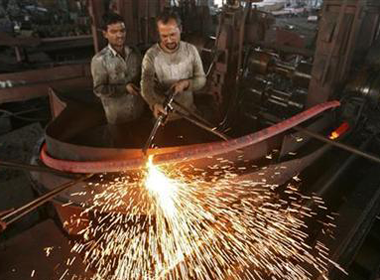If you are busy celebrating the spike in the Index of Industrial Production (IIP), which unexpectedly jumped by a perky 5 percent in February, don’t run to uncork the bubbly. You could be in for a shock in March. It will require herculean efforts to get factory output to levels where there is even zero growth. Yes, zero. Right now, one won’t be surprised if the March IIP even hits negative territory. Reason: it’s the base effect, stupid. The same base effect – a low IIP number in February 2014 – that enabled the index to hit 5 percent this year will cause it to huff and puff to strike a positive note. In February 2014, the IIP number was 172.7, while this year it was 181.3 – which is what made growth figure nearly 5 percent. It looks good because last year the IIP fell 2 percent in February. But the index number in March last year was much higher at 193.3 – which means even to achieve zero growth in March 2015, the IIP has to rise by 6.6 percent over what was achieved in February this year. The other way of looking at it is this: if the March IIP is not more than 6.6 percent (that is, if it does not cross 193.3), industrial growth will actually become negative again. However, there is no case for undue pessimism either. [caption id=“attachment_2151263” align=“alignleft” width=“380”]  Reuters[/caption] The fact is there is a revival of sorts going on, but it is not robust as yet. To really understand where we stand, we should look at the April 2014-February 2015 IIP rate so that short-term blips and slides are smoothened out. And the IIP for April-February shows a moderate rise to 2.8 percent compared to -0.1 percent in the corresponding period of 2013-14 (that is, stagnant production) - in the last year of the UPA. So P Chidambaram did leave behind a stagnating industrial economy. From static, we have now moved to first gear. This is the Modi government’s real achievement, and it is nothing to sniff at. The only sensible way to look at the IIP is over a long period, and the April-February figure tells us that growth is slowly rising in 2014-15, but not in a spectacular way. At best, we will see IIP growth for the whole year in the range of 2-2.5 percent, which means revival has not been strong so far. It is, however, useful to point to hopeful signs. The real growth is in two areas: basic goods (like steel, coal, power, etc) and capital goods (machinery). While the production of basic goods, which accounts for the largest chunk of nearly 45 percent of IIP, rose from 1.8 percent to 7.4 percent in April-February, capital goods rose from a negative -2.6 percent to 6 percent. The numbers indicate a small revival as businessmen are beginning to invest once more. Between them, basic and capital goods account for nearly 55 percent of the IIP. In other words, the big plates are moving in a positive direction. The weakness is in the area of intermediate goods (goods that are used in the production of other goods), and consumer goods. Growth in intermediate goods slowed down during April-February from 3.3 percent last year to 1.6 percent this year; consumer goods production fell even more from -2.9 percent to -3.7 percent. The final consumer – which means you, me and everybody else - is holding back on consumption expenditure. He is not sure achche din have arrived. Plus, there is the reality of rural distress, thanks to crop damage recently and also the effect of lower procurement prices last year – which was needed to contain inflation. The government has also been spending less on its rural schemes in order to curtail its fiscal deficit, and this has reduced rural spending power – which impacts consumer purchases. For consumer industries like soaps, toiletries, two-wheelers, and household goods, rural demand is the key to growth. The conclusion one should draw is this: while business confidence is slowly reviving, consumer confidence, especially in rural areas, continues to remain low. People are simply postponing many essential and other purchases. They are still waiting for achche din. True revival may happen only in 2015-16, the second year of the Modi govermment, assuming there is no major monsoon failure. A small shortfall will be taken in stride. Modi must pray for good rains this year. The rise in basic and capital goods indicates that the next recovery will be investment-led. Consumption will follow. In this context, the government’s decision to delay the fiscal consolidation plan and start public investments is a great call.
The IIP’s smart show in February is largely due to the base effect. The same base effect may produce a downer in March. So hold the celebrations. But a small-scale revival is underway, and it will gather steam in 2015-16
Advertisement
End of Article
Written by R Jagannathan
R Jagannathan is the Editor-in-Chief of Firstpost. see more


)

)
)
)
)
)
)
)
)



